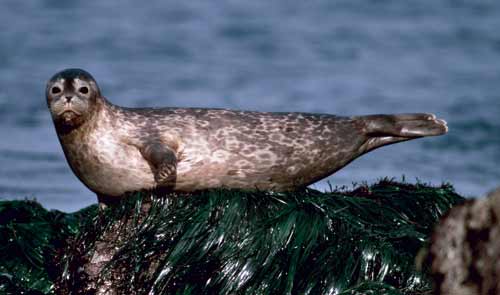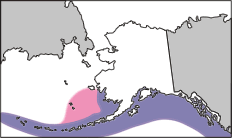Harbor Seal |
Phoca
vitulina Family: Phocidae |
 Photo © Thomas Mangelsen |
|
|
See a 3-D animation of a harbor seal skull. Read Arctic Science Journeys Radio stories and listen to audio: 
Distribution/Migration: Northern Hemisphere. In eastern North Pacific, from southern California to Pribilofs. Not migratory but make local seasonal movements in response to prey distribution. Pink shows summer range, purple shows year-round. This web page is modified from the book Marine Mammals of Alaska by Kate Wynne, illustrated by Pieter Folkens, available at the Alaska Sea Grant Bookstore. 
|
SIZE: Average adult 6 ft (1.8 m), 250 lbs. At birth 3 ft (1 m), 25 lbs. BODY: Medium, torpedo-shaped body with relatively large, round head and short limbs. COLOR: Variable from nearly white to nearly black with variable, contrasting colored spots, rings, or blotches. Pups born with spotted silver coat. BEHAVIOR: Usually solitary in water but haul out in groups of few to thousands. Inquisitive but elusive. May porpoise when swimming fast at the water surface. Dive <25 min, usually 5–8 min at depths to 600 ft (180 m). HABITAT: Near-coastal, estuarine. May be seen miles up rivers. Haul out on remote intertidal sandbars, rocky shores, ice. FOOD HABITS: Opportunistic. Eat wide variety of schooling fish, flatfish, crustaceans, squid. LIFE HISTORY: Sexually mature at 3–5 yrs. Breed July–August (in Alaska). Single pup per year, most born June (in Alaska) after 10-mo gestation. Pups weaned at 4–6 wks. Annual molt August-September in Alaska. Captive seals have lived 30+ yrs. STATUS AND HUMAN INTERACTIONS: Healthy throughout range but declining in some Alaska areas. Estimated >180,000 in Alaska. Subsistence harvest by Alaska Natives of approx 1600/yr for meat, blubber, and hide. Serious localized fishery conflicts if seals steal fish from nets or are incidentally entangled. Are known to accumulate pollutants. |
 Marine Education
Marine Education

